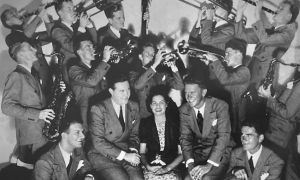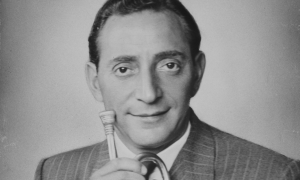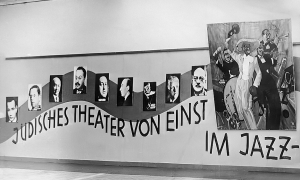Home » Jazz Articles » History of Jazz » Coleman Hawkins: Fifty Years Gone, A Saxophone Across Time
Coleman Hawkins: Fifty Years Gone, A Saxophone Across Time

Monk went into an emotional tailspin upon Hawkins’ death. Hawkins had been Monk’s first employer in the clubs of midtown Manhattan, and had given Monk his first recording date.
With Monk was the Baroness Pannonica de Koenigswarter, attendant to jazz royalty, in whose hotel suite Charlie Parker had died in 1955, and in whose borrowed home Monk would suffer a fatal stroke in 1982. Monk went into an emotional tailspin upon Hawkins' death. Hawkins had been Monk's first employer in the clubs of midtown Manhattan, and had given Monk his first recording date. Biographer Robin D.G. Kelley reports that Monk never played records made by others, but, sleepless over the next three days, he played those Hawkins albums repeatedly.
Coleman Hawkins: the name itself has a linguistic dignity unique to a music personage. Grouped with early figures in jazz, he may more generally be known about, even without specific recall, existing somewhere up in a Mt. Rushmore-worthy historical cloud. Fifty years after his passing, his music is still important and enjoyable in itself, and worthy of study beyond simple historic significance. It is generally accepted that every jazz saxophonist owes Hawkins for the place the horn occupies today.
Before Young and Webster
Born in 1904, Hawkins was five years older than the two great progenitors of tenor saxophone styles: Lester Young, who Hawkins outlived by ten years, and Ben Webster, who died five years after Hawkins. Hawkins thus preceded both Webster and Young, and was the first to raise the tenor as an instrument worthy of solos rather than a vaudeville novelty or mere accompaniment between clarinets and brass.Consider: his career started before the first recording of the Louis Armstrong Hot Five in 1925, and lasted right up to the cusp of the 1970s and fusion. There is no one else who played with both Armstrong when starting out and Sonny Rollins near the end; plus Monk, John Coltrane, Duke Ellington, Dizzy Gillespie, Django Reinhardt; mixed in a generation of swing musicians and another of bebop, impacted all, and then continued into the modern era.
Armstrong, for all his importance, never made it to free jazz and avant-garde; Coleman Hawkins did. Hawkins endured: from 1923 with the Fletcher Henderson swing band; an expatriate to Europe in the 1930s; into the 1940s with Monk, Max Roach, Gillespie, Miles Davis; in the 1950s with Monk and Coltrane; and, separately in the 1960s, again with Roach, Ellington, and Rollins.
Hawkins was four years older than Chu Berry, who followed Hawkins with a robust refinement such that his name was applied descriptively to horns constructed by the C.G. Conn company, the "Chu Berry Conn," still played by some today and revered for their tone, archival distinction, and quality and technological innovations for that time. Berry, tenor in Cab Calloway's Cotton Club band, lived only until 1941, killed in a car accident, age 33. The prominence Hawkins gave the instrument itself resulted in such individual exemplars becoming prized, like Chu Berry Conns, or Selmers.
Hawkins generally played lower notes than Lester Young, but higher than Ben Webster. Young was lyrical, sweet, fast, playing in the upper register of the instrument, often sounding more like an alto than a tenor, a "cool" sound, leading the way to cool jazz. Stan Getz, Gerry Mulligan, Paul Desmond stylistically follow Young. Webster played in the lower register, with a big tone, breathy ballads, and aggression. Dexter Gordon, John Coltrane, Sonny Rollins, and now Joshua Redman and Eric Alexander follow in that style. Charles Lloyd might best represent a combination of the two approaches now, with lightness and strength.
The Tenor Up Front
In the 1920s, the tenor sax was not used for improvisation, instead fitting in between clarinets and brass instruments in military and big bands. It was Louis Armstrong who broke out from the collective approach of musicians in bands large and small, with the innovation of soloing on trumpet.Hawkins was 19 when he joined Fletcher Henderson's orchestra in New York in 1923. Armstrong connected with Henderson in 1924, bringing his solo style, which inspired Hawkins on saxophone. Hawkins style became more fluid, legato, in place of a staccato dance band meter. Hawkins' individualism as a soloist on tenor would later be a bridge from the era of big band ensembles and swing to developments like bebop, which emphasized individual musicians in small groups.
Hawkins remained with Henderson for eleven years, but grew frustrated with the limitations of the musicians around him. Hawkins had acquired the nickname "Bean," for the mastery of his instrument and the intelligence he exhibited in understanding and applying theories of harmony.
Hawkins had been playing music since he was five years old, starting with piano and later cello, encouraged by his parents, and gravitated to saxophone by age nine. He attributed his skill to years of work. "Sure," he recalled in 1960, "I was advanced for my time in those early days, for just that reason—I had studied hard since I was five, and studied classics all my life, and it gives me an advantage over the other fellows I was playing with."
Enticed by reports of the warm response to American musicians in Europe, he left for a five-year sojourn to the continent in 1934 and was received enthusiastically. He played with multi-instrumentalist Benny Carter in various groups, including with guitarist Django Reinhardt. Lester Young briefly replaced Hawkins in Henderson's group, but was asked to leave because his light sound was so different from that of Hawkins, even after extensive coaching by Henderson's wife. Ben Webster took the tenor chair.
Upon returning to the U.S., Hawkins, then just still in his early 30s, already was considered an old-timer as Young had re-emerged as the new tenor with the Count Basie band 1936-1940. Jazz critic Whitney Balliet of The New Yorker observed there has long been a tendency among jazz aficionados to regard each innovation in the music as "progress," and then abandoning the musicians who have supposedly been supplanted. Thus, Hawkins, a founding father, had been pushed aside by the popularity of "Pres," Lester Young, "the president of the saxophone," so anointed by Billie Holiday in enjoyment of his playing.
Two "cutting sessions" between Hawkins and Young to determine primacy still engage partisan debate, now through hearsay among people who weren't there. Each was a master, of different styles: Young perhaps more refined, Hawkins perhaps rougher but more technically proficient. Young shrugged it off, suggesting that Hawkins was the "first president," and that "Pres" himself had followed as second president. Both men later played on the same stages in "Jazz at the Philharmonic" tours.
In the Firmament
In 1939 Hawkins assembled a nine-piece band and recorded "Body and Soul," a well-known ballad, in an improvisation that implies but never quite yields the actual melody. Rough edges had been polished away. The song was a jukebox hit, even with and perhaps because of its sophistication, and remains a classic. It predated Charlie Parker's treatment eight years later in 1947 of "Embraceable You," improvising on the familiar George Gershwin tune but also never stating the melody, except for a brief fragment at the end.Sonny Rollins recalls that Thelonious Monk once asked Hawkins, "Hawk, how could you make a song that's a ballad and you didn't play the melody, and there was no words and still it became a hit?"
Rollins himself is stumped by the question, about a song recorded now 80 years ago, but still timely and easily listenable. It smooths out some of the lyrical but jumpy "hot jazz" that otherwise characterizes some of that period by Hawkins, and is already more modern than what was then being played in the swing era. It has a lightness, but also a depth. Rollins: "'Body and Soul' is a masterpiece. It still is, will always be. Far be it beyond me to explain it. It's why Coleman Hawkins is in the firmament."
Rollins explains that what Hawkins brought to the development of jazz music required musicians to have a greater understanding of music theory than did Young. Young had a style, he says, but Hawkins required more from the intellect. Rollins has stated that, over time, the demarcations between the Young and Webster schools are more nuanced than strict, and that he, like others, has built his own efforts upon the legacies of both. Beyond each he looks back to Coleman Hawkins as the fountainhead.
At The Birth of Bebop
Hawkins was the leader on what is generally considered to have been the first ever bebop recording session, of "Woody'n You" on February 16, 1944, with Dizzy Gillespie and Max Roach. It was an homage to Woody Herman, known as a swing band leader, but who had nurtured Gillespie as an arranger. It was released on the Hawkins album Rainbow Mist, the title song itself being a reinterpretation of "Body and Soul." It also includes "Salt Peanuts," written by Gillespie and drummer Kenny Clarke, later a bebop standard popularized by Gillespie and Charlie Parker.Hawkins was fully middle-aged, 40, but took interest in the experiments and developments of the bebop youngsters, and advanced their cause. Hawkins knew Monk from Minton's Playhouse, the afterhours bebop incubator uptown in Harlem, and brought him downtown for Monk's first employment in the clubs of Manhattan's 52nd Street, from spring to late December in 1944. On October 19, 1944, Hawkins included him in what was the pianist's first recording date. Numbers included "Flying Hawk," "Drifting on a Reed," and "On a Bean," and appear on various reissues, most easily located now under "Bean and the Boys." In 1947, a 21-year-old Miles Davis cycled through a series of aggregations, among them the Coleman Hawkins All-Stars.
Hawkins was a mentor who understood and could complement what these younger musicians were doing compositionally, but he was not to stay with them. Their sound was more fervent than his own best playing. As Gillespie, Monk, and Charlie Parker became more closely associated with bebop, Hawkins moved on between styles and groups, with more traditional players who had gained a proficiency on their instruments through the swing era, and introducing what would become considered "modern," and then, later, "mainstream."
Being Modern
Hawkins reunited with Monk, with whom he hadn't played in years, in a June 1957 session including John Coltrane that would yield the classic Monk's Music album issued later that summer; the drummer was Art Blakey. Outtakes from this session would comprise half the tracks on another release, Thelonious Monk with John Coltrane, four years later, after each had gained greater recognition.This 1957 period was when Monk tutored Coltrane on the pianist's compositions and theories, and they performed together for five months in the Five Spot café. It was the period after Coltrane had been fired by Miles Davis for drug use, and then had experienced his spiritual recovery. Monk himself had begun that year in a psychiatric hospital. It is said that what they formulated in those months set the pattern for all that they would accomplish over the remainder of the lives, even their furthest reaches. Recording with them in this time frame was Coleman Hawkins, almost 35 years after breaking in with Fletcher Henderson.
On December 8, 1957, Hawkins, Young, and Webster all appeared together on a CBS television special, "The Sound of Jazz," performing with Billie Holiday her song "Fine and Mellow," available on YouTube. It's an opportunity to compare and contrast each man's playing, and watch Holiday's response to each. Young is sublime, Webster focused, Hawkins impassioned. Another, from 1958, "Jumpin' With Symphony Sid" has Young and Hawkins dueling: Hawkins strongly defines the parameters, and Young defies anyone who would think Pres was soft.
In 1960 Hawkins recorded on the Max Roach/Abbey Lincoln We Insist! Freedom Now Suite, a strongly politicized declaration linking jazz and the civil rights movement. In 1962, Hawkins recorded with Duke Ellington for the 1962 album Duke Ellington Meets Coleman Hawkins, with Ellington veterans in a small group, saxophonists Johnny Hodges and Harry Carney, trombonist Lawrence Brown, and Ray Nance on cornet and violin. Ben Webster had been Ellington's tenor from 1935 to 1943. Almost twenty years later, Ellington and Hawkins share top billing.
In 1963, Sonny Rollins and Hawkins played together at the Newport Jazz Festival, and followed up with a studio date released as Sonny Meets Hawk!. Lester Young had already been dead for four years. Rollins was venturing into free jazz, and Hawkins went with him. Rollins always held Hawkins in high regard, even idolized him, and each is respectful of the other.
This would be Hawkins' last album. On "Lover Man," both are exploring with their horns; as Rollins concludes with a squeaking altissimo, Hawkins is more grounded, but right with the younger man. Each addresses Gershwin's "Summertime" abstractly in his own manner. On "Yesterdays," Hawkins introduces a fluttering modernism that Rollins pursues. Rollins' identity then was as more of an experimenter, but Hawkins is not shy about the new idiom. Rollins does not overwhelm Hawkins, and Hawkins does not require careful handling.
The Ken Burns Jazz series singled out two dozen performers for dedicated retrospective albums, showcasing their significance. Coleman Hawkins was one of them. All About Jazz has more than a dozen articles describing and analyzing Hawkins in depth, easily found under his name in this site's search window. One in particular, by the late Henk De Boer, surveys a library of selected Hawkins recordings, a retrospective so complete it even includes a detour into bossa nova as Hawkins sought to be contemporary amid changing times. Read our coverage.
Hawkins' last performance was at the North Park Hotel in Chicago a month before he died. It was just a few months before Woodstock.
Tags
History of Jazz
Arthur R George
United States
Coleman Hawkins
Thelonious Monk
Charlie Parker
Lester Young
Ben Webster
Louis Armstrong
Sonny Rollins
John Coltrane
duke ellington
Dizzy Gillespie
Django Reinhardt
Fletcher Henderson
Max Roach
Miles Davis
Chu Berry
Cab Calloway
Stan Getz
Gerry Mulligan
Paul Desmond
Dexter Gordon
Joshua Redman
Eric Alexander
charles lloyd
Benny Carter
Billie Holliday
George Gershwin
Woody Herman
Kenny Clarke
Art Blakey
Johnny Hodges
Harry Carney
Lawrence Brown
Ray Nance
PREVIOUS / NEXT
Support All About Jazz
 All About Jazz has been a pillar of jazz since 1995, championing it as an art form and, more importantly, supporting the musicians who make it. Our enduring commitment has made "AAJ" one of the most culturally important websites of its kind, read by hundreds of thousands of fans, musicians and industry figures every month.
All About Jazz has been a pillar of jazz since 1995, championing it as an art form and, more importantly, supporting the musicians who make it. Our enduring commitment has made "AAJ" one of the most culturally important websites of its kind, read by hundreds of thousands of fans, musicians and industry figures every month.























